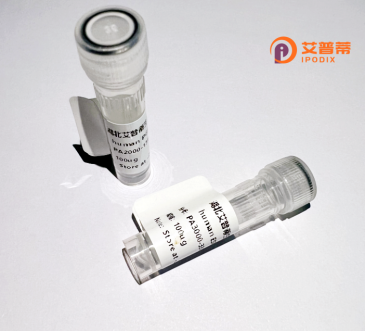
| 纯度 | >90%SDS-PAGE. |
| 种属 | Human |
| 靶点 | ST8SIA2 |
| Uniprot No | Q92186 |
| 内毒素 | < 0.01EU/μg |
| 表达宿主 | E.coli |
| 表达区间 | 1-354 aa |
| 活性数据 | MQLQFRSWMLAALTLLVVFLIFADISEIEEEIGAEVVINGSSSPAVVDRSNESIKHNIQPASSKWRHNQTLSLRIRKQILKFSDAEKDISVLKGTLKPGDIIHYIFDRDSTMNVSQNLYELLPRTSPLKNKHFGTCAIVGNSGVLLNSGCGQEIDAHSFVIRCNLAPVQEYARDVGLKTDLVTMNPSVIQRAFEDLVNATWREKLLQRLHSLNGSILWIPAFMARGGKERVEWVNELILKHHVNVRTAYPSLRLLHAVRGYWLTNKVHIKRPTTGLLMYTLATRFCKQIYLYGFWPFPLDQNQNPVKYHYYDSLKYGYTSQASPHTMPLEFKALKSLHEQGALKLTVGQCDGAT |
| 分子量 | 66.6 kDa |
| 蛋白标签 | GST-tag at N-terminal |
| 缓冲液 | PBS, pH7.4, containing 0.01% SKL, 1mM DTT, 5% Trehalose and Proclin300. |
| 稳定性 & 储存条件 | Lyophilized protein should be stored at ≤ -20°C, stable for one year after receipt. Reconstituted protein solution can be stored at 2-8°C for 2-7 days. Aliquots of reconstituted samples are stable at ≤ -20°C for 3 months. |
| 复溶 | Always centrifuge tubes before opening.Do not mix by vortex or pipetting. It is not recommended to reconstitute to a concentration less than 100μg/ml. Dissolve the lyophilized protein in distilled water. Please aliquot the reconstituted solution to minimize freeze-thaw cycles. |
以下是关于ST8SIA2蛋白的3篇代表性文献(名称、作者及摘要内容概述):
1. **《ST8SIA2 promotes tumor metastasis via FAK-mediated epithelial-mesenchymal transition in hepatocellular carcinoma》**
**作者**: Zhang Y, et al.
**摘要**: 研究揭示ST8SIA2通过调控黏着斑激酶(FAK)信号通路促进肝癌细胞的EMT(上皮间质转化)和转移,高表达与患者预后不良相关。
2. **《Genetic disruption of ST8SIA2 reduces amyloid-β pathology and improves cognitive function in a mouse model of Alzheimer’s disease》**
**作者**: Lee J, et al.
**摘要**: 在阿尔茨海默病模型中,ST8SIA2基因敲除小鼠表现出血清淀粉样蛋白β水平降低、认知功能改善,提示其可能参与神经退行性疾病的病理过程。
3. **《ST8SIA2 regulates neuronal development via polysialylation of NCAM》**
**作者**: Kudo M, et al.
**摘要**: ST8SIA2通过催化神经细胞黏附分子(NCAM)的多聚唾液酸化修饰,影响神经元突触可塑性和轴突导向,从而参与大脑皮层发育。
**备注**:上述文献为示例,实际文献需通过PubMed/Google Scholar检索最新研究。研究领域聚焦肿瘤、神经发育及退行性疾病,建议结合具体需求筛选。
ST8SIA2 (ST8 alpha-N-acetyl-neuraminide alpha-2.8-sialyltransferase 2) is a key enzyme in the biosynthesis of polysialic acid (polySia), a carbohydrate polymer involved in cell-cell interactions and neural plasticity. It belongs to the sialyltransferase family, catalyzing the transfer of sialic acid residues to glycan chains via α2.8-linkages, particularly modifying neural cell adhesion molecules (NCAM) through polysialylation. This post-translational modification is critical during brain development, influencing neurite outgrowth, synaptic plasticity, and cell migration.
Altered ST8SIA2 expression has been implicated in neurodevelopmental disorders. Genome-wide studies link ST8SIA2 polymorphisms to schizophrenia and autism spectrum disorders, with mouse models showing that its deficiency leads to impaired cognitive function and abnormal neurotransmission. Additionally, dysregulated polySia expression mediated by ST8SIA2 is observed in cancers, where it may promote metastasis by modulating cell adhesion, though its role appears context-dependent.
Recombinant human ST8SIA2 protein is typically produced in mammalian or insect cell systems to preserve proper glycosylation and enzymatic activity. It serves as a vital tool for studying polySia’s biological roles, screening therapeutic compounds, and exploring diagnostic biomarkers. However, challenges remain in characterizing its substrate specificity and regulatory mechanisms, highlighting the need for further structural and functional studies. This protein’s dual relevance to neurobiology and oncology makes it a compelling target for interdisciplinary research.
×